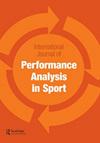柔道间歇大腹和扎训练后的生理和知觉负荷的比较
IF 2.1
4区 教育学
Q1 Health Professions
International Journal of Performance Analysis in Sport
Pub Date : 2022-06-01
DOI:10.1080/24748668.2022.2084593
引用次数: 0
摘要
摘要本研究调查了uke和tori在间歇性osaekomi-waza运动中生理和感知反应的差异。21名男性柔道运动员自愿参与了这项研究。在进行人体测量和1分钟的uchi-komi测试后,运动员们在kesa gatame作为uke和tori的情况下,进行了20秒×6组(工作-休息比例为1∶½)的间歇osaekomi waza运动。在运动后休息、1分钟和6分钟监测运动员的心率和乳酸浓度,同时运动员对运动后感知的用力率进行分类。在实验过程中,间歇运动后,uke姿势与tori姿势的心率变化值较高的姿势之间存在差异(F2,40=4.28,p=0.03)。此外,uke位置的运动员比tori位置的运动员表现出更高的感知用力等级(p=0.01)。然而,不同体位的血乳酸反应相似(p>0.05)。间歇的osaekomi-waza运动导致uke和tori体位的代谢负荷相似,而与tori体位相比,uke体位的心血管负荷更高。因此,可以得出结论,与托里姿势的运动员相比,uke姿势的运动员暴露于更多的心血管负荷,并表现出更高的感知反应。本文章由计算机程序翻译,如有差异,请以英文原文为准。
Comparison of physiological and perceptual load between uke and tori after intermittent osaekomi-waza exercise in judo
ABSTRACT This study investigated differences in physiological and perceptual responses between uke and tori during intermittent osaekomi-waza exercise. Twenty-one male judo athletes voluntarily participated in this study. Following anthropometric measurements and 1 min uchi-komi test, athletes executed 20 s × 6 sets (1:½ work rest ratio) intermittent osaekomi-waza exercise with kesa-gatame as both uke and tori. Athletes’ heart rate and lactate concentration were monitored at rest, 1 min, and 6 min following the exercise while the athletes classified the rate of perceived exertion just after the exercise. During the experiment, the changes in heart rate were different between positions with higher values in uke position compared to tori position after the intermittent exercise (F2,40 = 4.28, p = 0.03). Moreover, athletes in the uke position stated a higher rating of perceived exertion than athletes in the tori position (p = 0.01). However, blood lactate responses were found to be similar between positions (p > 0.05). Intermittent osaekomi-waza exercises resulted in similar metabolic load for uke and tori positions, while higher cardiovascular load was observed in the uke position compared to the tori position. Thus, it can be concluded that the athletes in uke position are exposed to more cardiovascular load compared to those in tori position and present higher perceptual responses.
求助全文
通过发布文献求助,成功后即可免费获取论文全文。
去求助
来源期刊

International Journal of Performance Analysis in Sport
SPORT SCIENCES-
CiteScore
4.70
自引率
4.80%
发文量
38
审稿时长
>12 weeks
期刊介绍:
The International Journal of Performance Analysis in Sport aims to present current original research into sports performance. In so doing, the journal contributes to our general knowledge of sports performance making findings available to a wide audience of academics and practitioners.
 求助内容:
求助内容: 应助结果提醒方式:
应助结果提醒方式:


